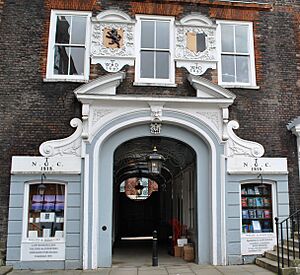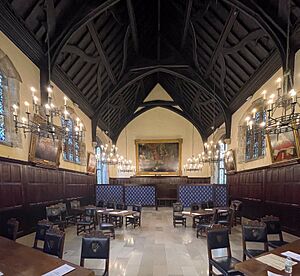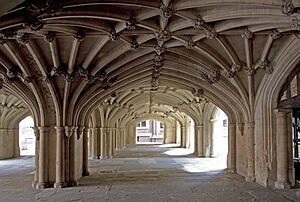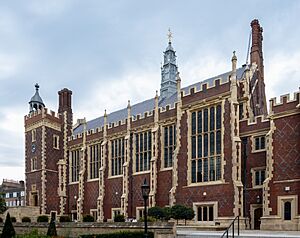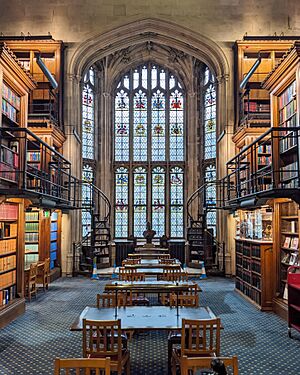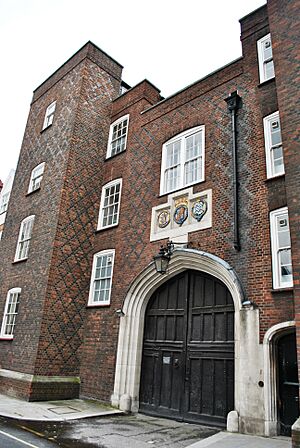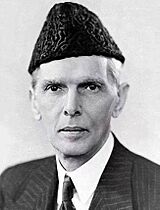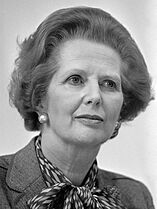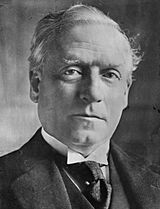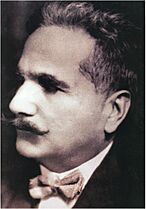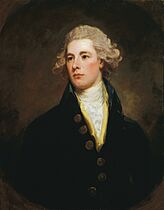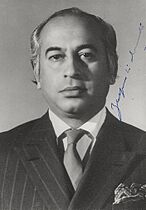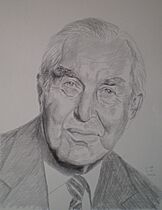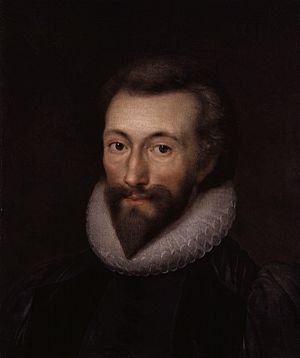Lincoln's Inn facts for kids
Lincoln's Inn is one of the four special places in London where barristers (a type of lawyer) in England and Wales train and become qualified to work. These places are called Inns of Court. The other three Inns are Middle Temple, Inner Temple and Gray's Inn.
Lincoln's Inn is located in an area called Holborn. It's close to important places like the Royal Courts of Justice and the London School of Economics. You can get there easily by tube, using Holborn tube station or Chancery Lane.
It's the largest of the Inns, covering about 11 acres. People believe it was named after a powerful person from the past, Henry de Lacy, 3rd Earl of Lincoln.
Contents
A Look Back: The History of Lincoln's Inn
For a long time, in the 1100s and early 1200s, lawyers were taught in the City of London, often by church leaders. But two big changes stopped this:
- In 1218, the Pope (the head of the Catholic Church) said that church leaders couldn't teach English law anymore. They could only teach church law.
- In 1234, King Henry III of England made a rule that no law schools could be inside the City of London.
So, the lawyers moved to a small area called Holborn. This was perfect because it was close to the law courts at Westminster Hall but outside the city limits.
Nobody knows the exact date Lincoln's Inn started. But it has the oldest records of all the Inns. Its "black books," which are like meeting minutes, go all the way back to 1422. These old records show that the Inn was already very organized back then.
It's thought that Henry de Lacy, 3rd Earl of Lincoln encouraged lawyers to move to Holborn. They first used a place called Thavie's Inn and then expanded to Furnival's Inn. Lincoln's Inn likely became a proper Inn of Court soon after the Earl died in 1310.
Before 1422, most of the lawyers, now known as "Lincoln's Inn" members, moved to land owned by the Bishop of Chichester near Chancery Lane. They kept Thavie's and Furnival's Inn as places for young lawyers to train. Lincoln's Inn officially became a place for legal education in 1464. This was when a "Reader" was required to give lectures to law students.
In 1920, Lincoln's Inn welcomed its first female member, Marjorie Powell.
How Lincoln's Inn is Run
Lincoln's Inn didn't have a written constitution (a set of rules) for a long time. Rules were made by different groups. Over time, the "Benchers" became the main group in charge.
In the 15th century, members were divided into different groups:
- Benchers: These were the most experienced and powerful members.
- Barristers: These were lawyers who had been "called to the Bar" and could argue cases in court. They were sometimes called "utter barristers."
- Inner Barristers: These were younger lawyers who were still training.
Back in the time of Lord Mansfield, there wasn't much formal legal education. To become a barrister, you mostly just had to eat five dinners a term at Lincoln's Inn!
Meet the Benchers
A Bencher is a special member of the Council, which is the group that runs Lincoln's Inn. The name "Bencher" comes from the fact that they used to sit on benches in the main hall during meals and practice trials.
The Benchers have been in charge for a very long time. They are usually senior judges, experienced lawyers called Queen's Counsel, or very successful "junior" barristers.
There are also "additional benchers" who are successful in other jobs, not just law. And "honorary benchers" are famous people who have been elected by the Inn, like Margaret Thatcher, a former Prime Minister of the United Kingdom.
Lincoln's Inn also has "Royal Benchers," who are members of the Royal Family. The current Royal Bencher is the Duke of Kent. In 1943, Queen Mary became the first female Bencher in any Inn. Prince Andrew, Duke of York was also elected a Royal Bencher in 2012.
Buildings and Special Places
Lincoln's Inn covers about 11 acres and has many buildings, including lawyers' offices and homes. It's surrounded by a brick wall, first built in 1562. Some say the famous writer Ben Jonson helped build it!
- New Square: This area was built between 1683 and 1697. It was originally called Serle's Court. Today, it has gardens and lawns in the middle.
- Stone Buildings: These were built between 1775 and 1780. They were meant to be part of a huge rebuilding project that never finished. They were damaged during World War II but still look much the same from the outside.
- No. 10 Stone Buildings: This building used to be the office for the Court of Chancery. Today, it's the headquarters for the Inns of Court & City Yeomanry, a part of the Territorial Army. Lincoln's Inn has had volunteers ready for war since 1585! King George III called them "The Devil's Own," a nickname that sticks to this day. There's a large War Memorial nearby, listing members who died in the World Wars.
- Old Square and Old Buildings: These parts were built between 1525 and 1609.
- Hardwicke Buildings: Built in the 1960s, these buildings were originally called "Hale Court."
Many of the buildings in Lincoln's Inn have offices for barristers and other legal professionals, with apartments on the top floors.
The Old Hall
The Old Hall has been around since at least 1489. It's 71 feet long and 32 feet wide. It has been changed many times over the years. Between 1924 and 1927, the entire hall was taken apart and put back together to fix problems and restore its original look. Queen Mary reopened it in 1928.
Besides being used for feasts and practice trials, the Old Hall was also a court. The Court of Chancery met here from 1737 until the Royal Courts of Justice opened. The Old Hall is famous for being mentioned at the start of Charles Dickens' book Bleak House.
Today, the Old Hall is used for exams, lectures, social events, and can be rented for private parties.
The Chapel
The first chapel at Lincoln's Inn was mentioned in 1428. It became too small, so a new one was built between 1620 and 1623 by Inigo Jones, a famous architect. It has been rebuilt and repaired many times since then.
The chapel is built over an open space called an undercroft, which has a cool, vaulted ceiling. This space has been used as a crypt (for burials), a meeting place, and a place for fun. For many years, only Benchers could be buried in the Crypt.
The chapel has a bell that might be from 1596. It used to chime a curfew at 9 pm, with one stroke for each year of the Treasurer's age. It also chimed when a Bencher died. Inside, there are six beautiful stained glass windows.
The chapel also has a pipe organ. The current organ was installed in 2009–2010. The chapel is often used for concerts.
The Great Hall
The Great Hall, also called the New Hall, was built in the 1800s. The Inn had grown so much that the Old Hall was too small. So, the Benchers decided to build a new, bigger hall and a library. The new building was designed by Philip Hardwick.
Queen Victoria herself opened the building on October 30, 1845. The Hall is 120 feet long, 45 feet wide, and 62 feet high – much bigger than the Old Hall! Today, the Great Hall is used for the "call to the Bar" ceremonies (when lawyers officially qualify), for dining, and for concerts.
The lower floor of the Great Hall now has a "Members Common Room," which is a club-like space with a bar and restaurant for members and tenants of the Inn.
The Library
The Library was first mentioned in 1471. The current Library was built as part of the same complex as the Great Hall and was also opened by Queen Victoria in 1845. It was later made even bigger in 1872.
The Library has a huge collection of rare books, including the "Hale Manuscripts" from Sir Matthew Hale, who left them to the Inn when he died in 1676. It also has over 1,000 other rare old papers and about 2,000 small booklets. In total, the Library has about 150,000 books! It's open to all students and barristers of Lincoln's Inn, as well as outside researchers and solicitors who apply.
It's mostly a reference library, meaning you can't usually borrow books.
The Gatehouse
The Gatehouse on Chancery Lane is the oldest part of the Inn that still stands. It was built between 1518 and 1521. A lot of the building was thanks to Sir Thomas Lovell, who was the Treasurer at the time. His family's coat of arms hangs on the gate, along with those of the Earl of Lincoln and King Henry VIII.
The Gatehouse is a tall tower with four stories. It has dark bricks arranged in diagonal patterns and big oak gates from 1564. It has been repaired several times over the years.
New Square Lawn
The New Square Lawn is a green space surrounded by the buildings of New Square. In the middle of the lawn is the Jubilee Fountain. This fountain was installed in 2003 to celebrate Queen Elizabeth's Golden Jubilee. It was paid for by David Shirley. The fountain has two levels, with water arches on the top and smaller fountains below.
New Buildings for Learning
Between 2016 and 2018, Lincoln's Inn made big improvements to its facilities. They built a new extension for the Library and added new teaching spaces. They even built a 150-seat Lecture Theatre and tutorial rooms underground, beneath the large east terrace of the Great Hall!
This new education area is called the Ashworth Centre, named after Mercy Ashworth, one of the first women to become a barrister at Lincoln's Inn. On December 13, 2018, Queen Elizabeth II and Prince Andrew, Duke of York officially opened the Ashworth Centre and the newly renovated Great Hall.
The Coat of Arms
For many years, Lincoln's Inn used the coat of arms of the 3rd Earl of Lincoln. This coat of arms showed a purple lion standing on its hind legs on a gold background.
Around 1699, the Inn found its own official coat of arms, which had been given to them in 1516. This coat of arms shows a blue background with many golden "fer moline" (a type of cross shape). In the top right corner, there's a small gold square with a purple lion standing on its hind legs. Since then, Lincoln's Inn has used this official coat of arms.
Famous Members
Many important people have been members of Lincoln's Inn, especially in politics:
- Muhammad Ali Jinnah: The founder and first leader of Pakistan.
- Sir Muhammad Iqbal: A famous Muslim poet, thinker, and politician from Pakistan.
- H. H. Asquith: A former Prime Minister of the United Kingdom.
- Zulfiqar Ali Bhutto: A former President and Prime Minister of Pakistan.
- William Ewart Gladstone: He was Prime Minister of the United Kingdom four times!
- Chaim Herzog: The sixth President of Israel.
- William Pitt the Younger: He was Prime Minister of the United Kingdom twice.
- Gnanendramohan Tagore: The first Asian person to become a barrister.
- Shankar Dayal Sharma: The 9th President of India.
- Azlan Shah of Perak: A former leader in Malaysia and Sultan of Perak.
- Tony Blair: A former Prime Minister of the United Kingdom.
- Basdeo Panday: A former Prime Minister of Trinidad and Tobago.
- Notable political alumni include:
Preachers of Lincoln's Inn
The Preacher of Lincoln's Inn is a church leader from the Church of England. Some famous past preachers include:
- John Donne (1616–1622)
- Reginald Heber (1822–?)
- Edward Maltby (1824–1833)
- William Van Mildert (1812–1819)
- Henry Wace
- William Warburton (1746–?)
- Derek Watson
- Hastings Rashdall
Other Groups at the Inn
- The headquarters of 68 Signal Squadron, a volunteer military group that is now part of the Territorial Army.
See also
- Lincoln's Inn Fields




